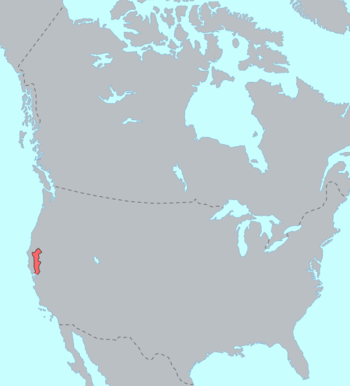- Wintuan languages
-
Wintun Copeh Ethnicity: Wintun people Geographic
distribution:California Linguistic classification: Wintun Subdivisions: Northern WintunSouthern Wintun
Pre-contact distribution of Wintuan languagesWintuan (also Wintun, Wintoon, Copeh, Copehan) is a family of languages spoken in the Sacramento Valley of central Northern California.
All Wintuan languages are severely endangered.
Family division
Shipley (1978:89) listed three Wintuan languages in his encyclopedic overview of California Indian languages. More recently Mithun (1999) split Southern Wintuan into a Patwin language and a Southern Patwin language, resulting in the following classification.
I. Northern Wintuan
II. Southern Wintuan
- 3. Patwin (aka Patween)
- 4. Southern Patwin (†)
Wintu may only have 2 speakers left. Nomlaki has few to none speakers. One speaker of Patwin (Hill Patwin dialect) remained in 1997. Southern Patwin, once spoken by the Suisun local tribe just northeast of San Francisco Bay, became extinct fairly soon after contact with whites and is thus poorly known (Mithun 1999). Gordon (2005) reports 5-6 speakers total for all Wintuan languages. Wintu proper is the best documented of the four Wintuan languages.
Pitkin (1984) considers the Wintuan languages as close to each other as the Romance languages. They may have diverged from a common tongue only 2,000 years ago.
The Wintuan family is a sometime member of the hypothetical Penutian language phylum or stock. It was one of five member families of the original California kernel of Penutian, proposed by Roland B. Dixon and Alfred L. Kroeber (1913a, 1913b). However, it is now established that Wintuan is a relatively recent arrival to California—with northern and southern Wintuan perhaps arriving separately, and that traditional California Penutian (in any case a historical artifact of when the languages were studies) cannot be valid. Wintuan languages share vocabulary with Klamath and Alsea which appear to be loans (Delancey and Golla 1997; Liedtke 2007; Golla 2007:75-78).
Bibliography
- DeLancey, Scott; & Golla, Victor. (1997). The Penutian hypothesis: Retrospect and prospect. International Journal of American Linguistics, 63, 171-202.
- Dixon, Roland R.; & Kroeber, Alfred L. (1903). The native languages of California. American Anthropologist, 5, 1-26.
- Dixon, Roland R.; & Kroeber, Alfred L. (1913a). New linguistic families in California. American Anthropologist, 15, 647-655.
- Dixon, Roland R.; & Kroeber, Alfred L. (1913b). Relationship of the Indian languages of California. Science, 37, 225.
- Dixon, Roland R.; & Kroeber, Alfred L. (1919). Linguistic families of California. University of California Publications in American Archaeology and Ethnology 16:47-118. Berkeley: University of California.
- Golla, Victor. (2007). Linguistic Prehistory. California Prehistory: Colonization, Culture, and Complexity, pp. 71–82. Terry L. Jones and Kathryn A. Klar, editors. New York: Altamira Press. ISBN 978-0-7591-0872-1.
- Gordon, Raymond G., Jr. (Ed.). (2005). Ethnologue: Languages of the world (15th ed.). Dallas, TX: SIL International. ISBN 1-55671-159-X. (Online version: http://www.ethnologue.com).
- Grant, Anthony. (1997). Coast Oregon Penutian. International Journal of American Linguistics, 63, 144-156.
- Liedtke, Stefan. (2007).The Relationship of Wintuan to Plateau Penutian. LINCOM studies in Native American linguistics, 55. Muenchen: Lincom Europa. ISBN 9783895863578
- Mithun, Marianne. (1999). The languages of Native North America. Cambridge: Cambridge University Press. ISBN 0-521-23228-7 (hbk); ISBN 0-521-29875-X.
- Pitkin, Harvey. (1984). Wintu grammar. University of California publications in linguistics (Vol. 94). Berkeley: University of California Press. ISBN 0-520-09612-6.
- Pitkin, Harvey. (1985). Wintu dictionary. University of California publications in linguistics (Vol. 95). Berkeley: University of California Press. ISBN 0-520-09613-4.
- Schlichter, Alice. (1981). Wintu Dictionary. Report #2 of the Survey of California and Other Indian Languages. Department of Linguistics, University of California at Berkeley.
- Shepherd, Alice. (1989). Wintu texts. Berkeley: University of California Press. ISBN 0-520-09748-3.
- Shipley, William F. (1978). Native Languages of California. Handbook of North American Indians, Vol. 8 (California), pages 80–90. William C. Sturtevant, and Robert F. Heizer, eds. Washington, DC: Smithsonian Institution. ISBN 0-16-004578-9 / 0160045754.
- Shepherd, Alice. (2006). Proto-Wintun. University of California publications in linguistics (Vol. 137). Berkeley: University of California Press.
- Whistler, Kenneth W. (1977). Wintun Prehistory: An Interpretation based on Linguistic Reconstruction of Plant and Animal Nomenclature. Proceedings of the Third Annual Meeting of the Berkeley Linguistics Society, February 19–21. pp. 157–174. Berkeley.
- Whistler, Kenneth. (1980). Proto-Wintun kin classification: A case study in reconstruction of a complex semantic system. (Doctoral dissertation, University of California, Berkeley).
External links
- Ethnologue: Wintu
- Native Tribes, Groups, Language Families and Dialects of California in 1770 (map after Kroeber)
- Morphological Parallels between Klamath and Wintu (Scott DeLancey)
- The Wintu Language Project
- Rosetta Project: Wintu
- Wintu (Wintun)
Categories:- Indigenous languages of California
- Languages of the United States
- Wintuan languages
- Endangered indigenous languages of the Americas
- Indigenous languages of the Americas stubs
Wikimedia Foundation. 2010.
